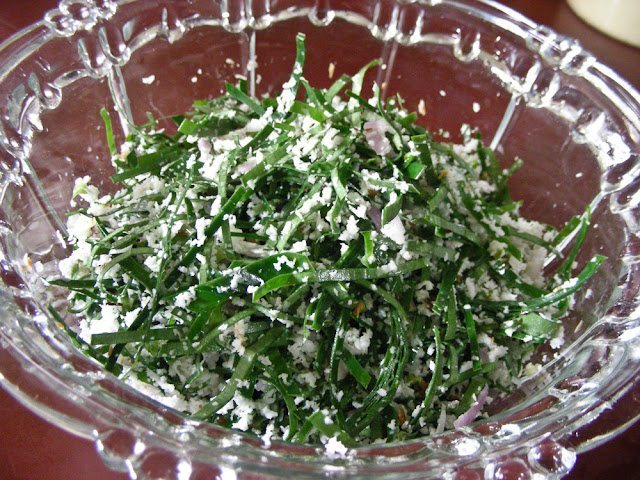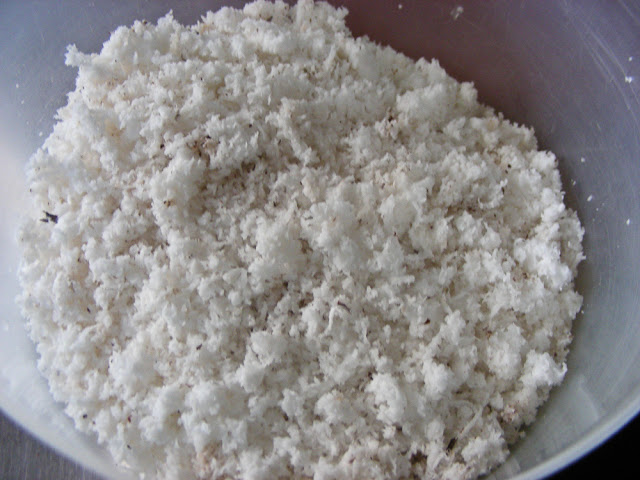
A little over a year ago, when our house helper lady came to work, she brought us some stalks of thebu. She does this sometimes – brings edible vegetation. Miscellaneous leaves or stalks of this or that. I don’t mind – I’m up for the adventure. 🙂
The thebu she brought is Costus speciosus. That’s basically a type of ginger plant. The variety she brought is not ornamental, but edible, and we planted the stalks.
These ginger leaves – called thebu here – have a faint gingery taste and were actually quite tasty. She made it into a sambol – mixed with freshly shredded coconut, lime juice (or perhaps a sour tangerine variant called norang), salt, and onion. Very nice. The flavour was pleasantly surprising and definitely something we’ll willingly have again. 🙂
Never thought I’d eat ginger leaves. 🙂
A year later, and my thebu patch is quite established, although briefly damaged by the papaya mealybug that’s infested so many plants here. But the papaya mealybug wipes off easily enough from these leaves, so it made sense to salvage what was still edible and make it into a sambol.

Thebu Sambol
Ingredients
- 2 cups thebu, sliced finely across the leaf
- 2 green chillies, minced
- 1 small onion, minced
- 1 lime, juice of
- 1/2 teaspoon salt
- 1 teaspoon Maldive fish flakes
- 1 cup coconut, freshly shredded
Directions
- Combine all ingredients and mix thoroughly.
- Serve immediately.
Sri Lankans will insist that all sambols taste better if they’re mixed with your hands. They’re probably right. My mother in law squeezes the lime juice onto the Maldive fish flakes, lets that sit for a minute or two for the fish flakes to absorb the liquid, then sort of mashes the Maldive fish flakes in with the green chillies and onion, then with the coconut and then the thebu or other leaves. This makes the Maldive fish flakes softer and also ensures the flavours are thoroughly combined. And I do it the same way. 🙂


I wasn’t aware that Thebu was of ginger family. The variant I’ve had a few times looked so much from the Crotan family (I’m not sure there’s such a thing as Crotan family), or was it? I had something which looked like a Crotan, but I’m not too sure it was Thebu. I’m pretty sure it was anyway. It was sure tasty. When I commented that the plant looked like a Crotan, someone told me it is from the Crotan family. Maybe people from different parts of the country call Thebu for different plants. My experience was in down south.
.-= Gaveen´s last blog ..gaveen: Still awake. No craving for brains. I guess that qualifies as not being a zombie yet. =-.
Sorry, I was inaccurate. Ginger and Costus speciosus are of the same order, Zingiberales. Ginger is in family Zingiberaceae, Zingiber officinale. Costus speciosus is in the family Costaceae. More info can be found at http://en.wikipedia.org/wiki/Costus_speciosus and http://en.wikipedia.org/wiki/Ginger
We have crotons in our yard. This is one. http://srilanka.laurieashton.com/2009/09/project-365-day-5-croton/
From what I’ve found, it doesn’t look like crotons are edible, or at least considered edible. I’m wondering if you’ve gotten other plants in the Costus family confused with crotons?
I didn’t know thebu was a name given to more than one plant. I asked Fahim, and he said thebu doesn’t really translate, so I gather the word is not very helpful in distinguishing things…
Thanks for the comment. 🙂
Ah, my mistake. I had the opportunity to ask my Mom about this. She confirmed that what she call Thebu is the plant with ginger like leaves you mentioned.
My confusion was about something known “Koppa Kola”. That plant looks terrifyingly similar to Crotan. Still very tasty. 🙂
No worries. I’m easily confused by a lot of things myself. 🙂 Thanks to your mom for helping clear things up. 🙂
You now have me very curious about Koppa Kola, especially since you say it’s very tasty. If you get the chance, would you mind taking photographs so I can see what you’re talking about? I haven’t found anything online about it.
This is good for blood sugar.
Could you kindly publish the picture of that plant called Thebu.
I’ll try to get a picture or two up in the next couple of days. I did have pics, but very recently moved my blog, which broke them.
Ranjith, the pictures are up. Enjoy. 🙂
I was in Sri Lanka for 3 months since January 2014. A friend introduced me to Thebu leaves because I am a juvenile Diabetic. I am now 61. I ate it on a daily basis as a salad [described above], or chewed 5 leaves [tasted mildly sour], or juiced it [ tasteless ]. My sugar levels went down rapidly. On such days I didn’t have to take Insulin.
It is better than bitter gourd. when I discussed the benefits with vendors and people who used it frequently, they said it was the best they have discovered to control diabetes. It is also known as the Insulin leaf.
I planted few stems in a pot. Within 3 weeks, it grew rapidly. Thebu grows wild.
Vendors on the street have them in little bundles for Rs. 20. Arpico [ Colombo branches] get larger bundles for Rs. 25 each. A bundle would last for 5 days if taken on a regular basis. My suggestion is to take it every other day if one is a Type 2 Diabetic.
Interesting.I had my first taste of tebu with lunch yesterday.I am a Insulin dependent
diabetic.my blood sugar dropped to 65 mg.DL in 24 hours nessasating a reduction of insulin
Hi Gaveen & Laurier
Please excuse me and permit me to enter into your conversation. I have teasted koppa kola Mellum and sambola which is very teasty. The shape of the leaves is like a cup about 6-8cm and the plant is almost like croton. Now I am in Australia and looking for koppa kola here in Australia. If you come across the English name of this plant ( if there is any) or botanical name, can you please publish it here.
Gamini, I followed a link on Google that said that koppa kola is Polyscias scutellaria. Does that look like the koppa kola that you’re talking about?